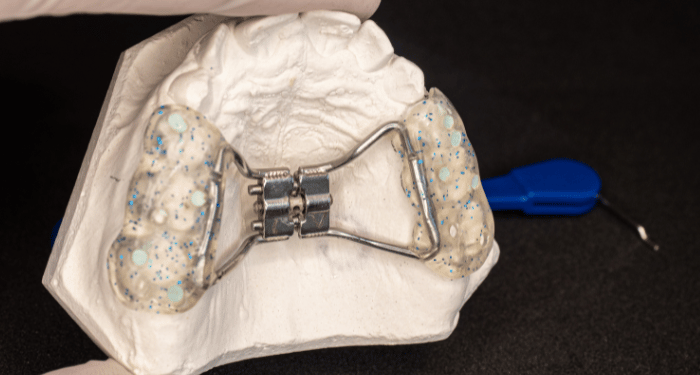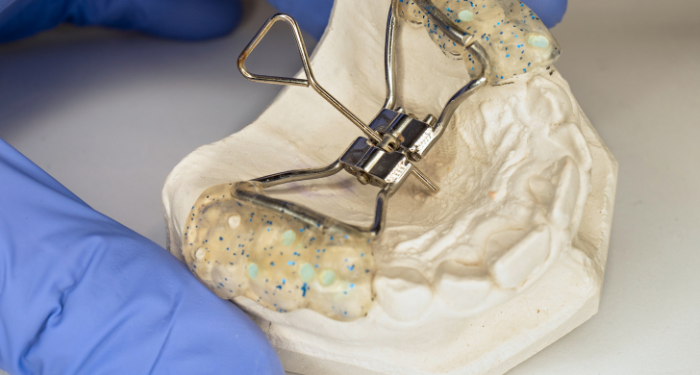
Let’s talk about palatal expanders… because chances are, if you’re navigating airway issues, tongue ties, speech delays, or orthodontic plans, expanders are going to come up. A lot.
And here’s the thing: not all expanders are created equal. From lightwire appliances to slow and rapid expanders, each one has a specific purpose, and not every option is right for every patient.
Whether you’re a provider guiding families through the options (though keep in mind prescribing and recommending expansion or an expansion appliance is in scope for dental and orthodontic colleagues, specifically), or a parent staring down an orthodontic recommendation you’ve never heard of, this blog breaks it all down.
So… What Is a Palatal Expander, Really?
In simple terms: it’s a device designed to widen the upper jaw. But that small explanation carries some pretty big implications- because a narrow palate can impact breathing, sleep, feeding, speech, tongue posture, and even facial development.
There are different types of expanders, and choosing the right one depends on age, goals, tolerance level, and overall plan of care. (We recommend you consult with your orthodontist or airway dentist on the type of expander that is right for you or your child. The following is for educational purposes.)
Rapid Palatal Expanders (RPEs)
Haas Expander
- Uses acrylic and metal to apply broad lateral pressure.
- Great for stable expansion with soft tissue support.
- Key-activated.
Hyrax Expander
- Metal-only design, anchored to molars.
- Common in kids and teens.
- Offers significant expansion, quickly.
- Also key-activated.
Biobloc Orthotropics
- Designed to guide jaw growth forward
- Best for kids with retracted jaws, poor tongue posture, & airway concerns
- 2 step system, key activated in phase 1 and muscle driven 2nd phase
Slow Expanders
DNA Appliance
- Daytime-Nighttime Appliance based on epigenetics.
- Stimulates natural bone growth.
- Gentle and functional for kids and adults.
- Provider-controlled activation and/or key-activated depending on appliance.
Schwartz Expander
- Removable option, great for mild-to-moderate cases.
- Caregiver/patient turns the screw at home.
- Less invasive but requires compliance.
Lightwire Functional Appliances
ALF Appliance
- Subtle, continuous pressure that works with the nervous system.
- Ideal for sensory-sensitive kids or those needing cranial balance.
- Often paired with CST or bodywork.
Crozat Appliance
- Gently supports expansion with lightwire.
- Great for gradual, subtle change when traditional expanders feel like “too much.”
Farrell Bent Wire System (BWS)
- A holistic favorite.
- Balances cranial function while supporting the palate and airway.
- Often used alongside Myobrace or myofunctional therapy.
Myofunctional-Orthodontic Hybrids
Myobrace
- No screws, no wires. Just guided oral posture and muscle training.
- Best for mouth breathing, tongue thrust, or poor muscle tone.
Myomunchee
- Looks like a chewy toy but acts like a powerhouse.
- Strengthens oral muscles through chewing for a few minutes per day.
Hallie’s oldest daughter, now 9, had an upper and lower ALF expander for a year age 4-5, took a break after achieving age appropriate expansion, needed more expansion at age 6 (as she was growing) and went into an upper and lower Hyrax RPE that was customized to include a component for forward expansion. She is on her last expander – upper and lower modified/customized haas expanders, which have proved to produce the most expansion, to date! At some point myobrace was recommended and attempted and was not a good fit. Hallie’s talked about this on the podcast.
Hallie’s youngest daughter, now 7, has also had an upper and lower Hyrax RPE with a customized forward growth component and used myobrace to hold her expansion. She is now in the same upper and lower modified Haas expander as her older sister and having fantastic results!
But Wait… What About Adults?
Great question. For teens and adults whose midpalatal sutures have fused, expansion isn’t as simple. Which brings us to:
MARPE: Micro-Implant Assisted Rapid Palatal Expansion
You heard it here first- Hallie is about to begin her own MARPE journey!
This is a big deal because:
- It’s an advanced, bone-anchored expander used when traditional expansion isn’t enough. (Hallie had traditional expansion with an RPE and braces as a child).
- It involves placing mini-implants in the palate to help open the midpalatal suture.
- It’s one of the few ways to achieve true skeletal expansion in skeletally mature patients.
Hallie’s planning to document her journey step-by-step…from consults to activation to what she really thinks about the process, any side effects (good or bad) and if it really lives up to all the hype in the airway world!
You’ll get to follow along and see what it’s like in real time- and spoiler alert: she’ll be sharing the good, the tough, and everything in between.
Want to follow along Hallie’s MARPE journey? Make sure you’re subscribed to the blog and following on Instagram @halliebulkin because this is about to get real.


